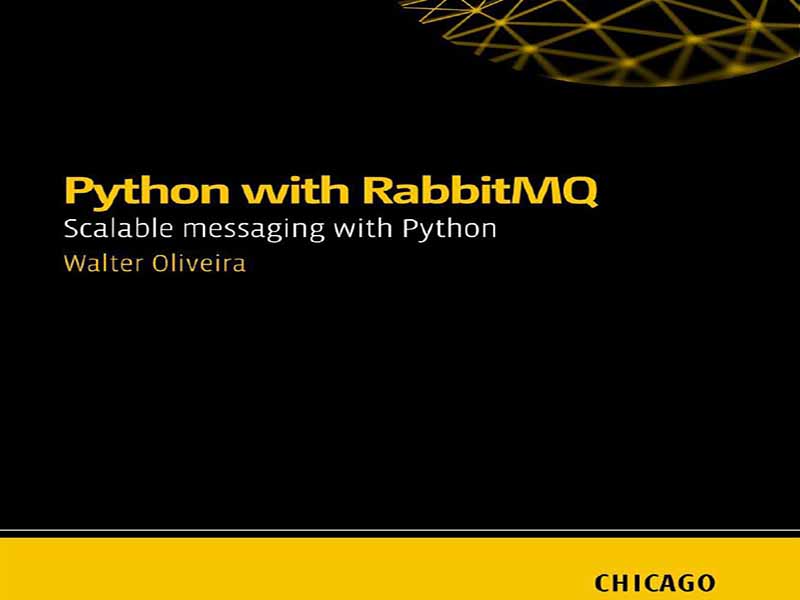- عنوان کتاب: Python with RabbitMQ -Scalable messaging with Python
- نویسنده: Oliveira, Walter
- حوزه: برنامهنویسی پایتون
- سال انتشار: 2025
- تعداد صفحه: 653
- زبان اصلی: انگلیسی
- نوع فایل: pdf
- حجم فایل: 41.2 مگابایت
سیستمهای پیامرسانی به یک جزء اساسی از برنامههای توزیعشده مدرن تبدیل شدهاند که امکان ارتباط بین سرویسها، برنامهها و سیستمهای مختلف را فراهم میکنند. با حرکت کسبوکارها به سمت معماریهای میکروسرویس و راهحلهای مبتنی بر ابر، نیاز به مکانیسمهای ارتباطی کارآمد و مقیاسپذیر به صورت تصاعدی افزایش یافته است. سیستمهای پیامرسانی امکان ارتباط غیرهمزمان، جداسازی اجزا و اطمینان از پاسخگویی و قابلیت اطمینان سیستمها را فراهم میکنند. در چنین محیطی، RabbitMQ به عنوان یکی از محبوبترین و پرکاربردترین کارگزاران پیام (message brokers) برجسته است و یک پلتفرم قابل اعتماد و انعطافپذیر برای مدیریت جریان پیامها بین سیستمها ارائه میدهد. RabbitMQ مبتنی بر پروتکل صفبندی پیام پیشرفته (AMQP) است، یک پروتکل استاندارد و باز که به سیستمهای مختلف اجازه میدهد پیامها را به روشی سازگار و قابل پیشبینی تبادل کنند. این پروتکل قوانینی را برای تحویل پیام، مسیریابی و مدیریت صف تعریف میکند که آن را برای ساخت سیستمهای پیچیده و توزیعشده ایدهآل میکند. RabbitMQ به عنوان یک کارگزار پیام، انتقال پیامها بین تولیدکنندگان و مصرفکنندگان را تسهیل میکند و تضمین میکند که پیامها حتی در مواجهه با خرابی یا اختلال در شبکه، به طور قابل اعتمادی تحویل داده میشوند. معماری انعطافپذیر آن، همراه با تضمینهای قوی تحویل پیام، آن را به کاندیدای قدرتمندی برای برنامههایی تبدیل میکند که نیاز به توان عملیاتی بالا و تحمل خطا دارند. از بسیاری جهات، RabbitMQ اصول میانافزار پیاممحور مدرن را در بر میگیرد. این برنامه از الگوهای مختلف پیامرسانی، از جمله نقطه به نقطه، انتشار/اشتراک و درخواست/پاسخ پشتیبانی میکند. این الگوها به توسعهدهندگان اجازه میدهند سیستمهایی طراحی کنند که بتوانند به راحتی مقیاسپذیر باشند و بارهای زیاد پیامها را بدون تحت فشار قرار دادن سرویسهای منفرد، مدیریت کنند. علاوه بر این، پشتیبانی RabbitMQ از چندین کلاینت و پروتکل، همراه با قابلیتهای مسیریابی قدرتمند آن، تضمین میکند که پیامها میتوانند تحت هر سناریویی به گیرندگان مناسب هدایت شوند. با افزایش پیچیدگی برنامهها، توانایی RabbitMQ در ارائه تحویل پیام قابل اعتماد، حتی تحت بار سنگین، به طور فزایندهای اهمیت مییابد. یکی از مزایای اصلی RabbitMQ، توانایی آن در جداسازی سرویسها است. با استفاده از یک کارگزار پیام، سرویسها میتوانند بدون نیاز به دانستن جزئیات پیادهسازیهای یکدیگر، با یکدیگر ارتباط برقرار کنند. این جداسازی در معماریهای میکروسرویسها بسیار مهم است، جایی که سرویسها اغلب به طور مستقل توسعه، استقرار و نگهداری میشوند. با استفاده از RabbitMQ، سرویسها میتوانند پیامها را بدون تعامل مستقیم با سایر سرویسها به صفها ارسال کنند، که این امر وابستگیها را کاهش داده و انعطافپذیری سیستم را افزایش میدهد. علاوه بر این، RabbitMQ تضمین میکند که پیامها به روشی تحویل داده میشوند که الزامات قابلیت اطمینان و مقیاسپذیری برنامه را رعایت میکند. در این فصل، اصول پیامرسانی و RabbitMQ را بررسی خواهیم کرد و توضیح خواهیم داد که چگونه کار میکند و چرا به چنین بخش جداییناپذیری از توسعه نرمافزار مدرن تبدیل شده است. ما در مورد معماری RabbitMQ، نحوه پیادهسازی AMQP توسط آن و بررسی برخی از رایجترین موارد استفاده آن بحث خواهیم کرد. علاوه بر این، ما راهنمایی گام به گام در مورد نصب و پیکربندی RabbitMQ ارائه خواهیم داد و زمینه را برای پیادهسازی عملی فراهم میکنیم. در پایان این فصل، شما پایه محکمی در مفاهیم پیامرسانی و RabbitMQ خواهید داشت که شما را به دانش لازم برای ساخت برنامههای قوی و مقیاسپذیر با استفاده از این کارگزار پیام قدرتمند مجهز میکند.
Messaging systems have become a fundamental component of modern distributed applications, enabling communication between different services, applications, and systems. As businesses move towards microservices architectures and cloud-based solutions, the need for efficient and scalable communication mechanisms has grown exponentially. Messaging systems allow asynchronous communication, decoupling components and ensuring that systems remain responsive and reliable. In such an environment, RabbitMQ stands out as one of the most popular and widely used message brokers, providing a reliable and flexible platform for managing the flow of messages between systems. RabbitMQ is based on the Advanced Message Queuing Protocol (AMQP), a standardized and open protocol that allows different systems to exchange messages in a consistent and predictable manner. This protocol defines the rules for message delivery, routing, and queue management, which makes it ideal for building complex, distributed systems. As a message broker, RabbitMQ facilitates the transmission of messages between producers and consumers, ensuring that messages are delivered reliably, even in the face of failures or network disruptions. Its flexible architecture, combined with robust message delivery guarantees, makes it a strong candidate for applications requiring high throughput and fault tolerance. In many ways, RabbitMQ embodies the principles of modern messageoriented middleware. It supports various messaging patterns, including point-to-point, publish/subscribe, and request/response. These patterns allow developers to design systems that can scale easily and handle high loads of messages without overwhelming individual services. Moreover, RabbitMQ’s support for multiple clients and protocols, along with its powerful routing capabilities, ensures that messages can be directed to the right recipients under any scenario. As applications grow in complexity, RabbitMQ’s ability to provide reliable message delivery, even under heavy load, becomes increasingly important. One of the major advantages of RabbitMQ is its ability to decouple services. By using a message broker, services can communicate without needing to know the specifics of each other’s implementations. This decoupling is crucial in microservices architectures, where services are often developed, deployed, and maintained independently. With RabbitMQ in place, services can send messages to queues without directly interacting with other services, which reduces dependencies and enhances system resilience. Furthermore, RabbitMQ ensures that messages are delivered in a manner that respects the application’s reliability and scalability requirements. In this chapter, we will explore the fundamentals of messaging and RabbitMQ, explaining how it works and why it has become such an integral part of modern software development. We will discuss RabbitMQ’s architecture, how it implements AMQP, and examine some of its most common use cases. Additionally, we will provide step-by-step guidance on installing and configuring RabbitMQ, setting the stage for practical implementation. By the end of this chapter, you will have a strong foundation in messaging concepts and RabbitMQ, equipping you with the knowledge necessary to build robust and scalable applications using this powerful message broker.
این کتاب را میتوانید از لینک زیر بصورت رایگان دانلود کنید:
Download: Python with RabbitMQ




































نظرات کاربران